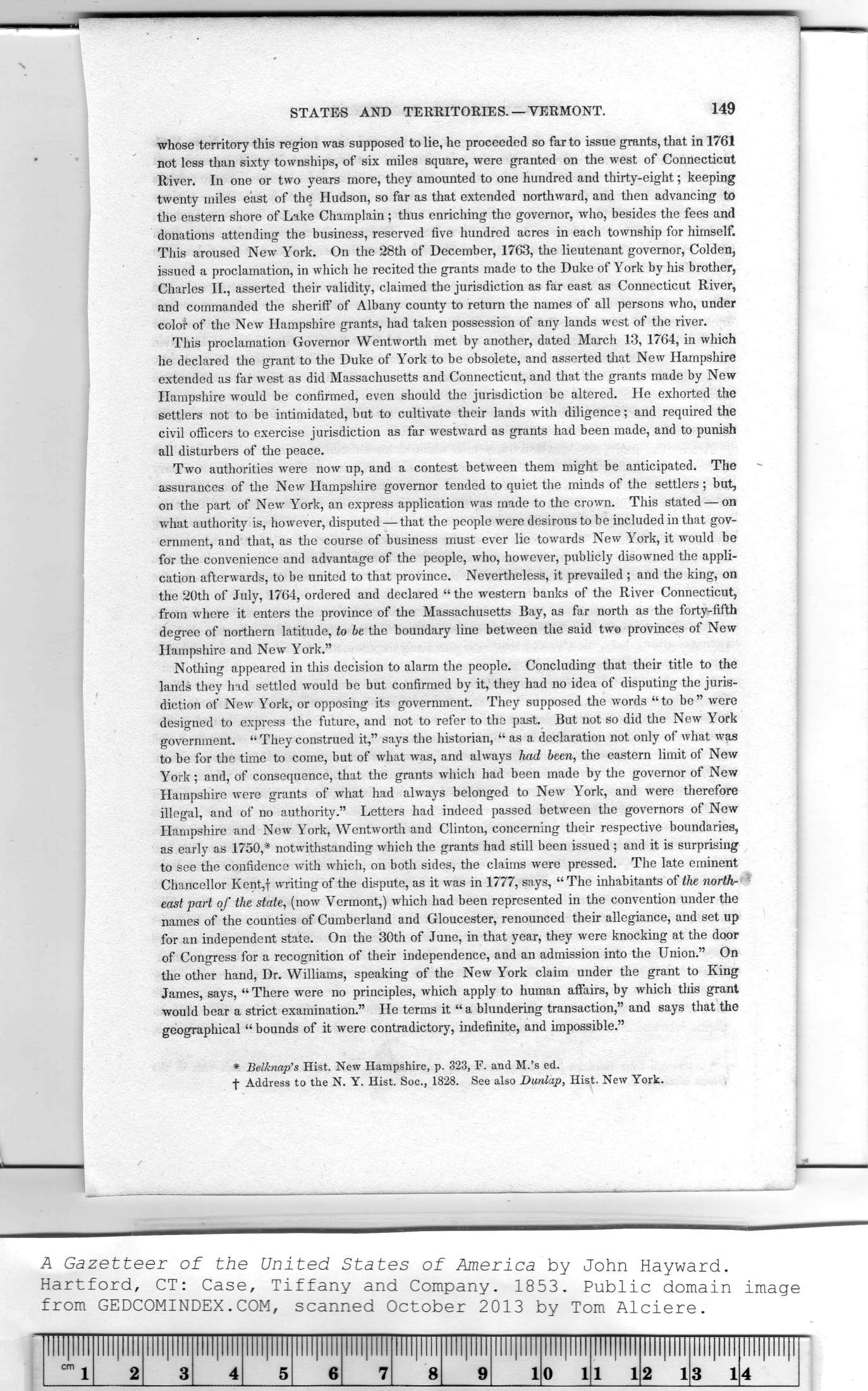|
|
Note: Ctrl and + increases the font size of the text below, Ctrl and - decreases it, and Ctrl and 0 resets it to default size.
STATES AND TERRITORIES.— VERMONT. 149
whose territory this region was supposed to lie, he proceeded so far to issue grants, that in 1761
not less than sixty townships, of six miles square, were granted on the west of Connecticut
River. In one or two years more, they amounted to one hundred and thirty-eight; keeping
twenty miles east of the Hudson, so far as that extended northward, and then advancing to
the eastern shore of Lake Champlain; thus enriching the governor, who, besides the fees and
donations attending the business, reserved five hundred acres in each township for himself.
This aroused New York. On the 28th of December, 1763, the lieutenant governor, Colden,
issued a proclamation, in which he recited the grants made to the Duke of York by his brother,
Charles II., asserted their validity, claimed the jurisdiction as far east as Connecticut River,
and commanded the sheriff of Albany county to return the names of all persons who, under
color of the New Hampshire grants, had taken possession of any lands west of the river.
This proclamation Governor Wentworth met by another, dated March 13, 1764, in which
he declared the grant to the Duke of York to be obsolete, and asserted that New Hampshire
extended as far west as did Massachusetts and Connecticut, and that the grants made by New
Hampshire would be confirmed, even should the jurisdiction be altered. He exhorted the
settlers not to be intimidated, but to cultivate their lands with diligence; and required the
civil officers to exercise jurisdiction as far westward as grants had been made, and to punish
all disturbers of the peace.
Two authorities were now up, and a contest between them might be anticipated. The
assurances of the New Hampshire governor tended to quiet the minds of the settlers ; but,
on the part of New York, an express application was made to the crown. This stated — on
what authority is, however, disputed — that the people were desirous to be included in that gov-
ernment, and that, as the course of business must ever lie towards New York, it would be
for the convenience and advantage of the people, who, however, publicly disowned the appli-
cation afterwards, to be united to that province. Nevertheless, it prevailed; and the king, on
the 20th of July, 1764, ordered and declared “ the western banks of the River Connecticut,
from where it enters the province of the Massachusetts Bay, as far north as the forty-fifth
degree of northern latitude, to be the boundary line between the said two provinces of New
Hampshire and New York."
Nothing appeared in this decision to alarm the people. Concluding that their title to the
lands they had settled would be but confirmed by it, they had no idea of disputing the juris-
diction of New York, or opposing its government. They supposed the words “to be" were
designed to express the future, and not to refer to the past. But not so did the New York
government. “ They construed it," says the historian, “ as a declaration not only of what was
to be for the time to come, but of what was, and always had been, the eastern limit of New
York ; and, of consequence, that the grants which had been made by the governor of New
Hampshire were grants of what had always belonged to New York, and were therefore
illegal, and of no authority." Letters had indeed passed between the governors of New
Hampshire and New York, Wentworth and Clinton, concerning their respective boundaries,
as early as 1750,# notwithstanding which the grants had still been issued ; and it is surprising
to see the confidence with which, on both sides, the claims were pressed. The late eminent
Chancellor Kent,f writing of the dispute, as it was in 1777, says, “ The inhabitants of the north-
east part of the state, (now Vermont,) which had been represented in the convention under the
names of the counties of Cumberland and Gloucester, renounced their allegiance, and set up
for an independent state. On the 30th of June, in that year, they were knocking at the door
of Congress for a recognition of their independence, and an admission into the Union." On
the other hand, Dr. Williams, speaking of the New York claim under the grant to King
James, says, “ There were no principles, which apply to human affairs, by which this grant
would bear a strict examination." He terms it “a blundering transaction," and says that the
geographical “ bounds of it were contradictory, indefinite, and impossible."
* Belknap's Hist. New Hampshire, p. 323, F. and M.'s ed.
f Address to the N. Y. Hist. Soc., 1828. See also Dunlap, Hist. New York.
|
lllllllll |
lllllllll |
lllllllll |
lllllllll |
llll|llll |
llll|llll |
|
|
lllllllll |
lllllllll |
lllllllll |
lllllllll |
lllllllll |
lllllllll |
llll|llll|l |
|
cm j |
2 |
3 |
4 |
5 |
6 |
7 |
8 |
9 |
1 |
0 1 |
1 1 |
2 1 |
3 1 |
4 |
|
